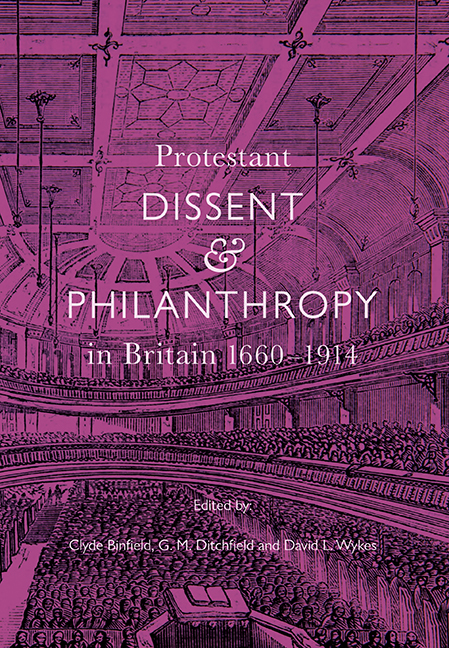Book contents
- Frontmatter
- Dedidcation
- Contents
- List of Illustrations and Tables
- List of Contributors
- Acknowledgements
- List of Abbreviations
- Introduction
- 1 Dissent and Charity, 1660–1720
- 2 Dissenters and Charity Sermons, c. 1700 to 1750
- 3 John Howard, Dissent and the Early Years of Philanthropy in Britain
- 4 Rational Philanthropy: Theory and Practice in the Emergence of British Unitarianism, c. 1750–1820
- 5 David Nasmith (1799–1839), Philanthropy Expressed as Campaigning
- 6 Building Philanthropy: The Example of Joshua Wilson (1795–1874)
- 7 Funding Faith: Early Victorian Wesleyan Philanthropy
- 8 Unitarians and Philanthropy After 1844: the Formation of a Denominational Identity
- 9 Children and Orphans: Some Nonconformist Responses to the Vulnerable in Victorian Britain
- 10 The Rowntree Family and the Evolution of Quaker Philanthropy, c. 1880 to c. 1920
- 11 ‘Not slothful in business’: Enriqueta Rylands and the John Rylands Library
- Select Bibliography
- Index
- STUDIES IN MODERN BRITISH RELIGIOUS HISTORY
5 - David Nasmith (1799–1839), Philanthropy Expressed as Campaigning
Published online by Cambridge University Press: 21 March 2020
- Frontmatter
- Dedidcation
- Contents
- List of Illustrations and Tables
- List of Contributors
- Acknowledgements
- List of Abbreviations
- Introduction
- 1 Dissent and Charity, 1660–1720
- 2 Dissenters and Charity Sermons, c. 1700 to 1750
- 3 John Howard, Dissent and the Early Years of Philanthropy in Britain
- 4 Rational Philanthropy: Theory and Practice in the Emergence of British Unitarianism, c. 1750–1820
- 5 David Nasmith (1799–1839), Philanthropy Expressed as Campaigning
- 6 Building Philanthropy: The Example of Joshua Wilson (1795–1874)
- 7 Funding Faith: Early Victorian Wesleyan Philanthropy
- 8 Unitarians and Philanthropy After 1844: the Formation of a Denominational Identity
- 9 Children and Orphans: Some Nonconformist Responses to the Vulnerable in Victorian Britain
- 10 The Rowntree Family and the Evolution of Quaker Philanthropy, c. 1880 to c. 1920
- 11 ‘Not slothful in business’: Enriqueta Rylands and the John Rylands Library
- Select Bibliography
- Index
- STUDIES IN MODERN BRITISH RELIGIOUS HISTORY
Summary
On 17 November 1839, in a Guildford inn, a man lay dying in agonising pain. He had arrived by train at Woking Common the previous evening and travelled on by coach with every expectation of meeting prospective allies and holding a public meeting to promote a town mission, along with female missions, maternal associations, young men's societies, servants’ homes, and various other schemes to assist the poorer classes of Guildford society. He was known as a philanthropist, although today we would probably term him a campaigner. He approached those with money to give and charitable intentions and proposed practical schemes for achieving them. What distinguished him from hundreds of others was his infectious enthusiasm and his energetic persistence in his self-appointed mission. His achievements would be celebrated in the obituaries that followed his sudden and unexpected death. He was forty years old and his name was David Nasmith.
Nasmith's early career
Born in Glasgow on 21 March 1799, David Nasmith came from a conventional religious background in the Church of Scotland's College Church. His childhood coincided with the growth of support for the principles of the evangelical revival, especially amongst a group of ministers and lay people influenced by followers of George Whitefield. Prominent among these in Scotland were the Haldane brothers and Greville Ewing. Rejecting the established Church of Scotland they moved towards Congregationalism. Nasmith was influenced by this movement and in adolescence he joined the Nile Street Church, where Ewing was the minister. This was created by Congregationalist seceders from a church formed by Robert Haldane, who had become a Baptist in 1808. Nasmith's biographer, John Campbell, was a fellow member at this time and hence praises Nasmith as ‘a Christian of no party’, which was how those who are now termed Congregationalists liked to describe themselves. There was no formal denominational structure of the kind found later in the nineteenth century. Ewing was a missionary enthusiast and it is no surprise that by the time he was aged seventeen Nasmith had formed ambitions to be an overseas missionary, ambitions that were thwarted when he was turned down for training. One way of interpreting his life subsequently is that he never gave up his missionary vocation, though he chose alternative ways of fulfilling it.
- Type
- Chapter
- Information
- Protestant Dissent and Philanthropy in Britain, 1660–1914 , pp. 95 - 112Publisher: Boydell & BrewerPrint publication year: 2020



